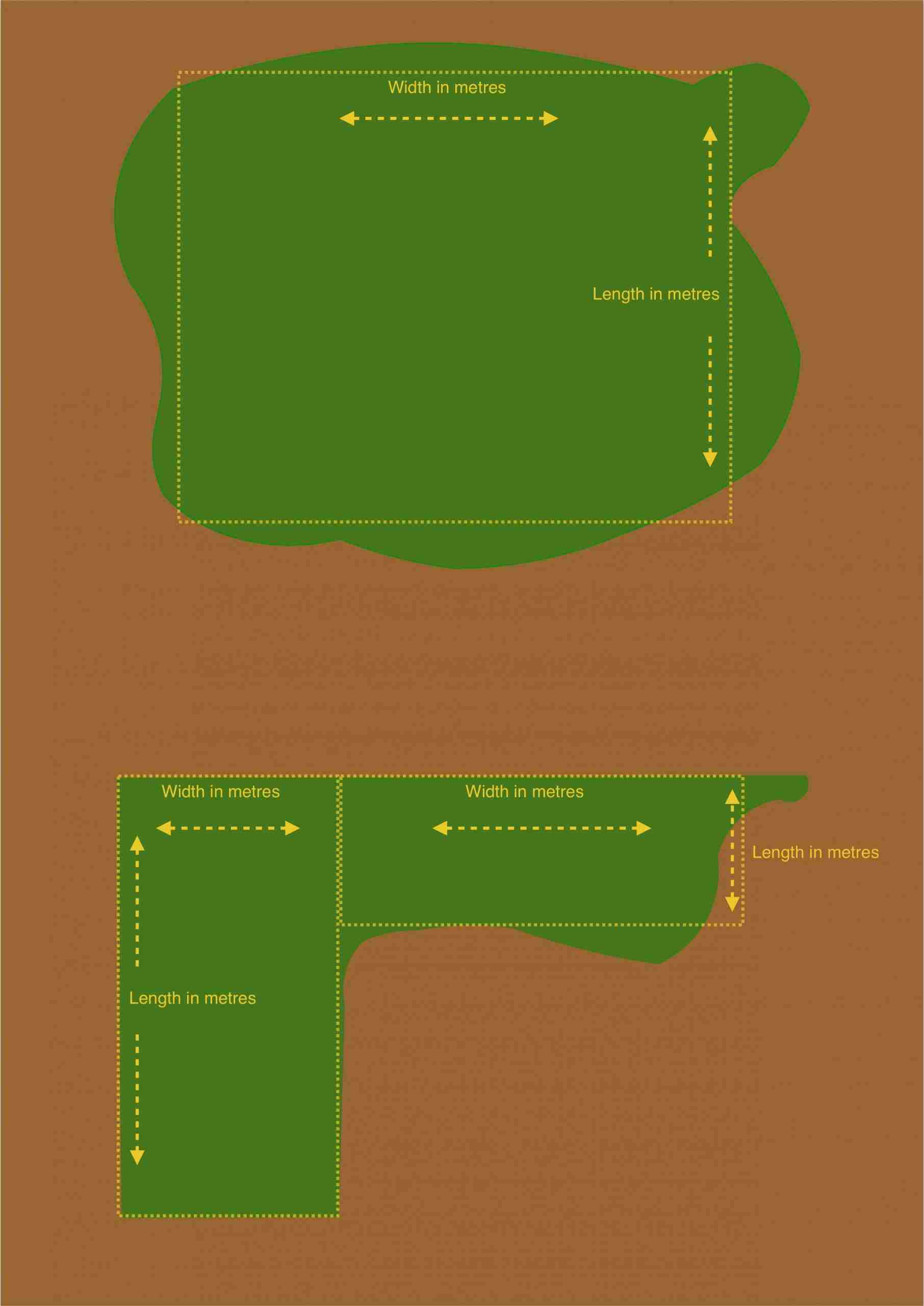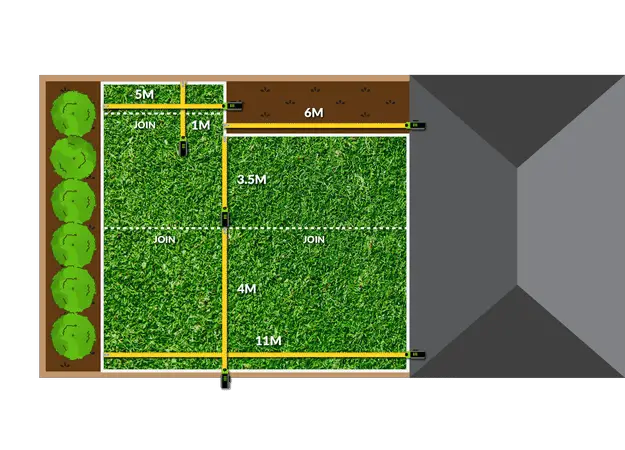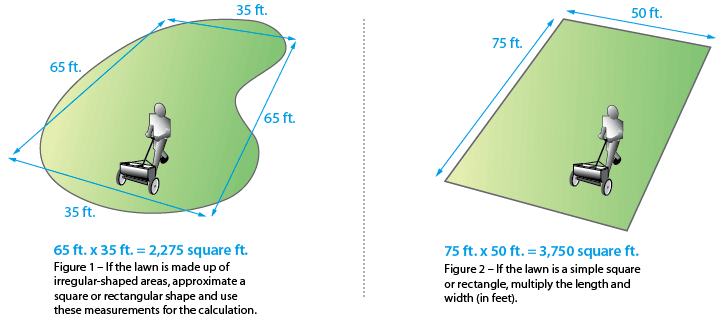How To Calculate The Amount Of Fertilizer Needed For Your Lawn
- Joseph Heckman, Extension Specialist in Soil Fertility
Fertilizer recommendations for lawns are usually given in pounds of nitrogen to be applied per 1,000 square feet. Home gardeners sometimes have difficulty converting these recommendations to the amounts needed for their selected grade of nitrogen fertilizer and their lawn size. This fact sheet provides conversion tables and examples showing you how to calculate the amount of fertilizer needed for your lawn.
Dont Get Mixed Up Between Gradient And Angle Of Inclination
This is an important point, as it is very easy to get the gradient and angle of inclination mixed up and make an error, resulting in purchasing a robot mower will not be able to handle the slopes in your garden. The gradient and angle of inclination are measuring the same thing, but are calculated and expressed in different ways.
As outlined previously, gradient is the rise of the slope, divided by the run of the slope, expressed as a percentage. The angle of inclination is the angle of the slope expressed in degrees. My advice would be to pick one way and stick to it. It will make each model easily comparable and, if necessary, you can convert from one to the other using an online calculator.
Whilst many manufacturers will provide both the maximum angle of inclination and gradient for their products, many express the gradient of the slope as a percentage in some marketing material, and the angle of inclination in degrees in other material, which doesnt help with clarity.
The Gradient Of A Slope
Having calculated the rise and run of the slope of your garden, you can now calculate the gradient of this slope. This is done very simply by dividing the rise of the slope by the run of the slope, ensuring that both of your measurements use the same units. The actual units do not matter. It can be centimetres, metres, feet or whatever you are most comfortable with, but both measurements must be in the same unit. You then multiply your answer by 100, to get the percentage slope. For example, a 2 metre rise divided by a 20 metre run = 0.1. Multiply this by 100 and we get a 10% slope.
You May Like: Wide Bladed Grass In Lawn
What Height Should A Lawn Mower Be Set At
Often, the tallest setting on your mower will be 3. So, remember this when adjusting your lawn mower height. Depending on what time of year you are mowing your yard, cool seasons, or warm seasons, determine what height your mower should be set.
As you have read in the earlier paragraphs, proper height is determined by the type of grass and time of year. Mowing your grass to the correct height will encourage deep root growth, retain moisture, prevent weeds, and keep your lawn looking healthy and green.
How To Measure For Sod

In order to figure out how much sod you need for your project you will need to measure the areas that you plan to sod.
Grab a pen, paper & measuring tape and head outside to jot down some measurements.
It can seem daunting to do the math, but its all going to start with measuring.
Make a quick sketch of your yard especially if you have large yard or irregular shaped areas.
Break your yard up into smaller sections if needed, to make it easier. Measure the areas in feet and jot down the measurements as you go.
Remember to take out any areas that will not require sod house, garage, decks, patios, side-walks, gardens, sheds, etc. Be as accurate as possible.
Due to the perishable nature of sod, we do not take returns. And we cant be responsible for yards that we did not measure.
If you are having trouble or have questions call our office and we can assist you.
Peat Sod Facts
In order to calculate the amount of sod required you must measure the length and width of the areas in feet.
Length x Width= square feet divided by 9 will give you the number of square yards needed.Example: 45 x 25 = 1125sq ft / 9 = 125 sq yards
- Our sod rolls measure 24 x 81 or 2 ft x 6.75 ft.
- Each roll of sod will cover 1.5 sq. yds or 13.5 sq. ft.
- 60 rolls per pallet = 90 sq yds per pallet
If you need a quote or help figuring out your requirements please call 269-3052and we will gladly assist you.
Measuring for sod and measuring irregular shapes.
Don’t Miss: Violet Killer For Lawns
When Should I Fertilize My Lawn
The best time to apply fertilizer depends partly on your climate, but especially on the type of turf you have. It is recommended fertilizing during the season when your grass grows the most.
In Quebec, the best growing seasons are fall and spring, since it is at these times that grasses are in full growth.
The soil must be fertilized when actively growing since it is during this period of time that it will be best able to absorb the nutrients it needs.
Using A Quality Fertiliser
In short, there are three main elements required to properly feed and fertilise your lawn effectively and efficiently, they are Nitrogen, Potassium and Phosphorus.
So, before choosing the best fertiliser you must understand what these three elements do:
Nitrogen gives your lawn its rich, green colour and creates strong, sturdy leaves.
Potassium works with N to make the roots and foliage stronger. It gives your lawn a greater chance of resisting drought, wear and tear as well as pests and diseases.
Phosphorus works underground making your lawns roots strong, especially heading into winter.
A good quality fertiliser contains all the main elements that your lawn requires and is suitable for your lawn type.
Good quality fertilisers can either be liquid or granular depending on your budget and lawns requirements.
Don’t Miss: Next Rgs Fertilizer
Measuring Your Lawn The Right Way
Measuring your lawn is more than just throwing a tape measure around. Rarely is a lawn a perfect square, and you can almost always rely on something blocking you from measuring in a straight line from one end to the other.
Using a copy of the documents showing your property lines and an aerial view of your home from Google Maps, break your lawn into small, measurable sections. Make the sections as square as possible to ease the calculation process and number them for easy tracking.
With the sections mapped out, there are a few ways to get the measurements you need. You can go old school with a tape measure or measuring wheel, or you can venture into the 21st century and let a computer do the work with estimating software.
The Best Option To Measure Your Lawn Area
Please take 5 minutes to get the app below, it might just save you from a costly mistake on measuring.
If you have an iPhone under utilities is a measure app that can be used to calculate distance or a great app that we use is:
This app simply walks you around your yard as you click on points and gives you a total square footage. Ive used it hundreds of time with almost perfect measurements.
After you have your measurements, visit the link below to get an instant price on your sod or an installation estimate:
Read Also: Where Are Cub Cadet Lawn Mowers Made
Here Are The Heights That Some Specific Types Of Grasses Like To Be Mowed At:
- Tall fescue between 2 inches to 3 ½ inches
- Kentucky bluegrass between 2 and 3 inches
- Bermuda grass between 1 and 2 inches
- Zoysia grass between 1 and 2 inches
- Buffalo grass between 2 3 inches
When mowing, take no more than 1/3 of the height of the grass blade. If too much is taken off, this is called scalping and will cause grass root systems to weaken and weeds to grow rapidly.
There are many ways to measure lawn height. The simplest method is to take a measuring stick and measure from the ground to the surface of the grass blade. Do this multiple times throughout your lawn to get a good average.
If you prefer a more modern method of measurement, there are devices available for purchase that will measure the height of the grass blade accurately. These include electronic meters and probes.
Test The Calculation To Get The Actual Measurement:
You should not apply the above-measured fertilizer directly on your lawn. You have to calculate how many passes it may require to feed your lawn properly, especially for the rotary spreader since it spreads instead of dropping on a location. You need to test some of the measurements to get a clear idea of how much you need to apply.
To perform the test,
Suppose you have got approximately 2 feet wide spray and the weight is 0.1 lbs. Suppose your lawn is 50 feet long and 40 feet wide. Then, if you want to cover along the length, you need to make 24 full paces maintaining 1 feet distance from the 2 borders.
The measurement is to give you a clear idea about the application by rotary spreader. The amount may vary if you want to increase the spread which will decrease the passing number and the speed you are maintaining.
A slower speed means lower spread in a small area but higher speed means higher spread in a large area.
Recommended Reading: How To Kill Wild Violet Weeds In Lawn
Guide To Measuring Your Lawn Ireland
Even the most awkwardly shaped lawns can be measured to a reasonable degree of accuracy if the correct approach is taken:
Square or rectangular lawn areas are easily calculated by multiplying the length by the width. Regardless of the units of measurement used, simply enter the details into our Emerald Lawn calculator and the required area will be determined.
An example
C x D = 9.9m2
Total Area = 38m2
Irregular shaped lawns should be sketched out on paper and then create as many squares or rectangles as necessary to cover your lawn sketch. Then each square or rectangle is easily calculated by multiplying the length by the width. Regardless of the units of measurement used, simply enter the details into our Emerald Lawn calculator and the required area will be determined.
Whatever the shape and size of your lawn, we strongly recommend that you purchase 5% more turf than you have calculated to cover for trimming losses. Our turf calculator automatically includes this margin.
Clean The Spreader And Water The Lawn

- After youve covered the lawn, check for any fertilizer that may have scattered onto your driveway, sidewalk or walkway. Use a broom and dust pan to clean these areas. Fertilizers contain minerals that can stain concrete. You can sprinkle any small amounts of leftover fertilizer back onto the lawn after you have scooped it up.
- Put the lawn spreader on the lawn and rinse it off with a garden hose. This allows you to make use of fertilizer thats stuck in and around the spreader. Clean the hopper plate and wheels thoroughly. Allow the lawn spreader to dry before storing it.
- Water the lawn thoroughly with a lawn sprinkler. This will mix the nutrients from the fertilizer into the soil.
Also Check: How Much Lime To Put On My Lawn
Recommended Reading: Peat Moss New Grass Seed
Let Us Measure It For You
We can come to your property and measure your lawn, but first we will try to get an idea of the lawn size, to give you an estimate of costs. After asking you a few questions about your lawn, we will locate your property on a map and measure your lawn, give you an estimate and if with in your buget come a visit your property to see if everything is suitable.
Simple Steps To Correctly Measuring Your Lawn
Star Tips
Youre about to drop some fertilizer, spread some seed, or treat your lawn for weeds, so you head out to pick up the product you need.
The problem is, youll quickly learn you needed to figure out how many square feet your yard is to know how much product to toss in your cart.
Making a guessing game out of this process can lead to 15 trips to the store to restock and listening to the cashiers attempt at humor each time. Worse yet, you could overestimate and be that guy standing at the customer service desk returning all of the extra fertilizer he didnt need.
With the right forethought and a little basic math, you can correctly measure your lawn and know precisely how much product to buy and the rate in which to spread it.
No, this isnt Ms. Zanders sixth-grade algebra class calculators, fingers, and toes are all welcome to get the right measurements here.
Read Also: Peat Moss And Grass Seed
How To Measure Your Lawn
Lawn treatment pricing is incredibly simple. In order for us to give you a price for your lawn we need to know how big it is. To measure the lawn simply measure the width and the length in metres and multiply the two together to get the size in square metres.
Dont worry if your lawn is not an exact square, simply imagine a rectangle in the lawn which covers the majority of the area as shown in the picture above, ignoring small irregular edges. If the lawn is very irregular as in the bottom picture, simply split it into smaller rectangles and add the areas together.
Why You Should Measure Your Lawn
Whenever you buy a bag of product for your lawn, you will see that it states approximately how much square footage of ground it will be able to cover.
Thats great, but only if you know what size your lawn actually is otherwise youre guessing.
Its important that you buy enough product to cover your lawn, but over-applying can burn your grass or alter your soils chemistry in a way that can permanently damage your lawn.
Measuring your lawn ahead of time allows you to buy right , and apply right .
Don’t Miss: Revive Lawn Treatment Review
How To Measure How Much You Are Watering Your Lawn
This is also a great activity for kids to be involved in so they learn the importance of water conservation.
Here is how you measure how much you are watering your lawn
Step 1 Check the water distribution for uniformity. You will need 4 containers we recommend milk cartons or soup cans.
Place the 4 containers in a grid pattern on the lawn that you are checkingRun your sprinklers for at least 10 min. If you have several stations that cover the area, run each station for the same amount of time.Check each container to see if the amount is the same. If you are not using the same size container or used a tin can and can not see through to check the water level. You can pour the water into a measuring cup, noting the volume each container contained.
If you find that you do not have even coverage, this could be a reason you have dry spots in the law. Adjust your sprinklers until they do cover the area evenly. If you do not know how to adjust your sprinklers, call to make an appointment with one of our sprinkler technicians.
Step 2 Determine the amount you are watering.
Empty the water from the 4 containers and measure 1/2 inch up from the bottom of the container.Place the 4 containers in a grid pattern on the law.Turn the sprinklers on and start a stopwatch.When your containers are filled to the 1/2 inch mark, stop the stopwatch and turn the sprinklers off.
Select The Type Of Spreader
Two types of spreaders are available in the market. One is rotary or broadcasting and the other is a drop spreader. Drop spreader drops fertilizers in a row at an even width . The type is handy for smaller lawns and makes several passes to complete even a small region than a rotary one.
The broadcasting spreader spreads fertilizers in a radius depending on the movement speed and size of the hopper holes. Best for larger lawns and reduces the passes to cover a lawn. Calibrating a drop spreader is much easier than a rotary spreader.
Also Check: How To Change Oil In Craftsman Lawn Mower
How To Measure Your Lawn For Fertiliser Application
When choosing a fertiliser, its always best to first know your lawn variety and size.
Knowing these two points will guide you on the way to selecting an appropriate fertiliser and the required amount. Fertiliser recommendations for lawns are based on the amount of nitrogen, phosphorus and potassium a lawn needs in a year.
How To Calculate Your Lawn’s Square Footage

This page is a general guide to calculating your lawn’s square footage. Using the methods or tips suggested, you can accurately measure and determine how much product to use in your residential or commercial property. Follow this guide and use the recommended methods or products and we guarantee 100% accuracy in measuring your lawn.
When beginning any treatment application knowing the size of your property is important to know. By understanding the property’s square footage and dimensions you can save time and money on the appropriate amount of herbicide, fungicide, or insecticide to purchase.
You May Like: Does Aarons Rent Lawn Mowers
